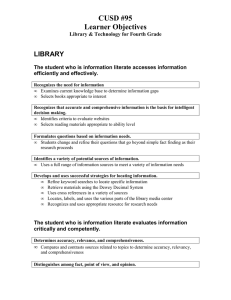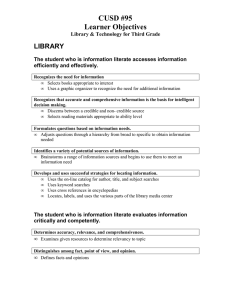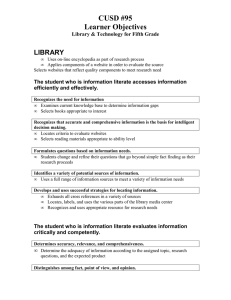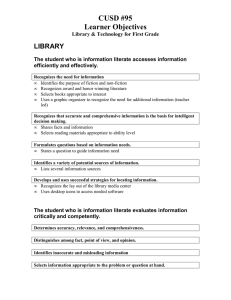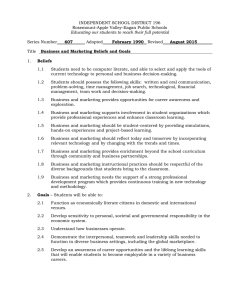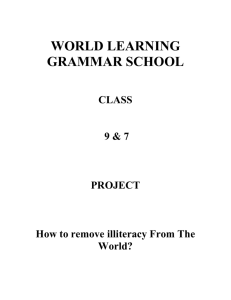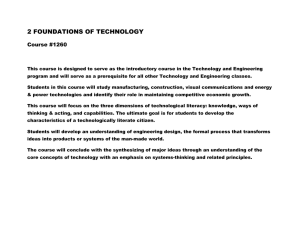CUSD #95 Learner Objectives LIBRARY
advertisement
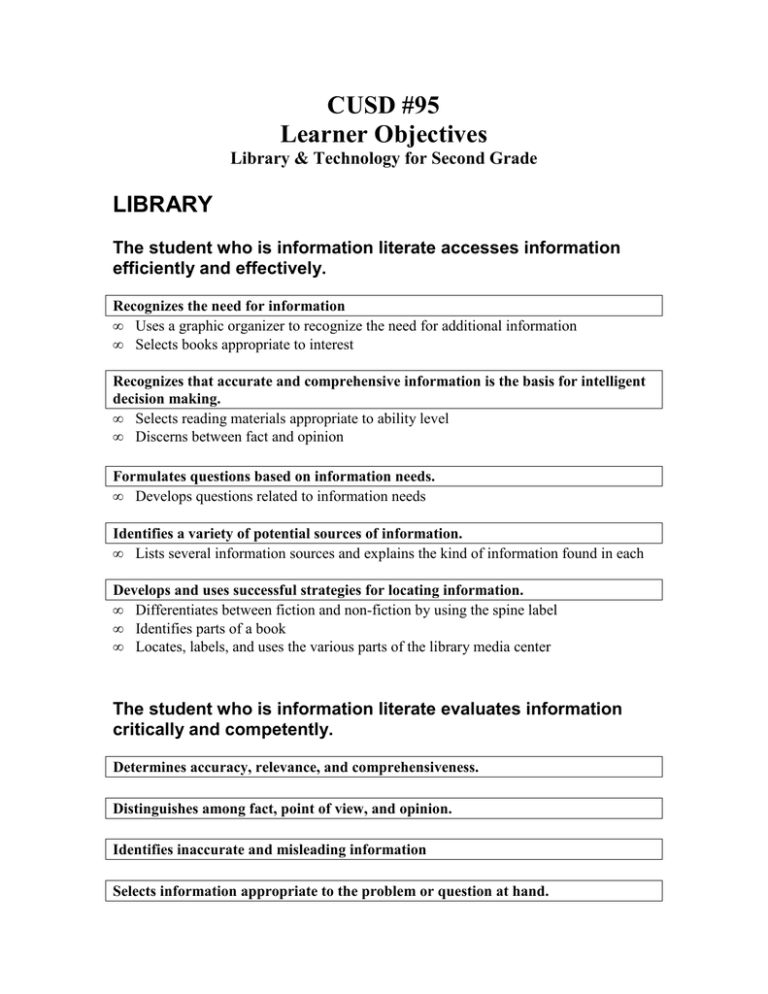
CUSD #95 Learner Objectives Library & Technology for Second Grade LIBRARY The student who is information literate accesses information efficiently and effectively. Recognizes the need for information • Uses a graphic organizer to recognize the need for additional information • Selects books appropriate to interest Recognizes that accurate and comprehensive information is the basis for intelligent decision making. • Selects reading materials appropriate to ability level • Discerns between fact and opinion Formulates questions based on information needs. • Develops questions related to information needs Identifies a variety of potential sources of information. • Lists several information sources and explains the kind of information found in each Develops and uses successful strategies for locating information. • Differentiates between fiction and non-fiction by using the spine label • Identifies parts of a book • Locates, labels, and uses the various parts of the library media center The student who is information literate evaluates information critically and competently. Determines accuracy, relevance, and comprehensiveness. Distinguishes among fact, point of view, and opinion. Identifies inaccurate and misleading information Selects information appropriate to the problem or question at hand. • Writes two to three facts in order to answer research question presented The student who is information literate uses information accurately and creatively. Uses information for practical application. • Organizes information into appropriate topics Integrates new information into one’s own knowledge. • Identifies multiple facts from a non-fiction source Produces and communicates information and ideas in appropriate formats. • Uses a variety of formats at a basic level to produce and communicate information The student who is an independent learner is information literate and pursues information related to personal interests. Seeks information related to various dimensions of well being such as career interests, community involvement, health matters, and recreational pursuits. • Builds upon an interest by seeking a variety of sources The student who is an independent learner is information literate and appreciates literature and other creative expressions of information. Is a competent and self-motivated reader. Derives meaning from information presented creatively in a variety of formats. • Explains information presented in a variety of formats The student who is an independent learner is information literate and strives for excellence in information seeking and knowledge generation. Assesses the quality of the process and products of personal information seeking. • Explains basic steps taken to locate information Devises strategies for revising, improving, and updating self-generated knowledge. • Explains and begins to use basic strategies for revising and improving product The student who contributes positively to the learning community and to society is information literate and recognizes the importance of information to a democratic society. Seeks information from diverse sources, contexts, disciplines, and cultures. Respects the principle of equitable access to information. • Demonstrates proper use of library materials • Uses technology efficiently so it is available for others to use The student who contributes positively to the learning community and to society is information literate and practices ethical behavior in regard to information and information technology. Respects the principles of intellectual freedom. Respects intellectual property rights. • Understands plagiarism and begins to translate text into own words • Constructs basic bibliographic record to include title, author, copyright date The student who contributes positively to the learning community and to society is information literate and participates effectively in groups to pursue and generate information. Shares knowledge and information with others. • Verbalize new facts in a small or large group setting • Communicates facts in a variety of ways Respects others’ ideas and backgrounds and acknowledges their contributions. • Uses appropriate listening skills while others are sharing information • Describes others’ ideas accurately and completely Collaborate with others both in person and through technologies to identify information problems and to seek their solutions. • Uses appropriate technology to express ideas Collaborates with others both in person and through technologies to design and develop information products and solutions. • Uses basic checklist to evaluate final product and makes necessary revisions TECHNOLOGY Students demonstrate a sound understanding of the nature and operation of technology systems. • Builds upon basic functions within a word processing program (i.e. font style and size, font color, centering text, using tools) • Inserts a graphic • Begins to utilize home row finger positioning during word processing • Demonstrates procedure for saving a file • Demonstrates procedure for printing a file Students use technology tools to enhance learning, increase productivity, and promote creativity. • Types a multi-sentence document Students use a variety of media and formats to communicate information and ideas effectively. • Produces a graphic organizer that contains two subtopics and supporting details • Produces a simple PowerPoint presentation Students use technology to locate, evaluate, and collect information from a variety of sources. • Locates and records information using age appropriate on-line sources
